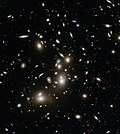Top Qs
Timeline
Chat
Perspective
Abell 2744
Galaxy cluster in the constellation Sculptor From Wikipedia, the free encyclopedia
Remove ads
Abell 2744, nicknamed Pandora's Cluster, is a giant galaxy cluster resulting from the simultaneous pile-up of at least four separate, smaller galaxy clusters that took place over a span of 350 million years, and is located approximately 4 billion light years from Earth.[1] The galaxies in the cluster make up less than five percent of its mass.[1] The gas (around 20 percent) is so hot that it shines only in X-rays.[1] Dark matter makes up around 75 percent of the cluster's mass.[1]
This cluster also shows a radio halo along with several other Abell clusters. It has a strong central halo, along with an extended tail, which could either be relic radiation, or an extension of the central halo.[4]
Renato Dupke, a member of the team that discovered the Cluster, explained the origin of the name in an interview: "We nicknamed it ‘Pandora's Cluster’ because so many different and strange phenomena were unleashed by the collision."[5]
Remove ads
Recent Observations and Discoveries
Summarize
Perspective
In February 2023, the James Webb Space Telescope (JWST) provided an unprecedented deep-field view of Abell 2744 as part of the Ultradeep NIRSpec and NIRCam Observations before the Epoch of Reionization (UNCOVER) program. This observation revealed approximately 50,000 sources of near-infrared light, showcasing the cluster's complex structure and its role as a powerful gravitational lens. The combined mass of the merging galaxy clusters creates a natural magnification effect, allowing astronomers to observe much more distant galaxies in the early universe by using the cluster as a cosmic magnifying glass.[6][7][8] Further studies utilizing ultra-deep X-ray observations from the Chandra X-ray Observatory have detailed the disruption of cool cores in the three X-ray luminous subclusters of Abell 2744. These findings confirm the presence of a shock to the northwest and suggest a complex merger history involving a head-on north-south merger approximately 0.5–0.6 billion years ago, followed by the first infall of a northwest subcluster.[9] Additionally, the gravitational lensing effect of Abell 2744 has facilitated the discovery of some of the most distant galaxies observed to date. Notably, UNCOVER-z13 and UNCOVER-z12 are high-redshift Lyman-break galaxies identified behind the cluster, with redshifts of 13 and 12.393, respectively. These discoveries provide valuable insights into galaxy formation and evolution during the early universe.
Recent observations of Abell 2744 using JWST medium-band imaging have revealed a population of galaxies with strong 3.3 μm polycyclic aromatic hydrocarbon (PAH) emission, indicative of dusty star formation. These PAH-selected galaxies, identified by an excess in the F430M filter, show star formation rates consistent with those derived from full UV-to-far-infrared spectral energy distribution fitting, validating the PAH feature as a reliable tracer. Most of these galaxies reside in low-density regions on the outskirts of the cluster, suggesting they are newly accreted along large-scale filaments previously observed in X-ray studies. Their recent starburst activity may be triggered by interactions during infall, with rapid quenching likely to follow due to cluster environmental effects such as ram-pressure stripping or heating by the intracluster medium. The spatial segregation of these galaxies from the cluster core supports this evolutionary scenario, highlighting the dynamic role of the cosmic web in shaping galaxy evolution within clusters.[10]
Remove ads
Gallery
- Abell 2744 parallel field observed as part of the Frontier Fields programme.[11]
- Abell 2744 intracluster light artificially colored in blue. This light come from galaxies that were torn apart long ago by the cluster's gravitational forces. [12]
- Abell 2744 galaxy cluster – extremely distant galaxies revealed by gravitational lensing (16 October 2014).[14]
- Pandora's Cluster observed by James Webb Space Telescope's NIRCam as part of UNCOVER program (15 February 2023).[15]
- The James Webb Space Telescope's infrared vision explores behind Pandora's Cluster.[16]
Remove ads
See also
References
External links
Wikiwand - on
Seamless Wikipedia browsing. On steroids.
Remove ads






